Surviving Hell: To See the Stars Again! ✨ 🌙
(Inferno, Canto XXXIV): Satan, the geography of hell and leaving to see the stars again!
It is easy to go down into Hell; night and day, the gates of dark Death stand wide; but to climb back again, to retrace one's steps to the upper air - there's the rub, the task.
~ A reminder from Virgil
Welcome to Dante Read-Along! 🌒
(If this post appears truncated in your inbox you can read it on the web by clicking here. )
Welcome to Dante Book Club, where you and I descend into Hell and Purgatory to be able to ascend to Paradise. Our guide is the great Roman poet Virgil and in this Thirty-fourth and last Canto of the Inferno, we arrive in the fourth ring of the Ninth Circle and encounter the Traitors to Lords and the massive Lucifer. You can find the main page of the read-along right here, reading schedule here, the list of characters here (coming soon), and the list of chat threads here.
In each post you can find a brief summary of the canto, philosophical exercises that you can draw from it, themes, character, and symbolism explanations.
All the wonderful illustrations are done specially for the Dante Read-Along by the one and only Luana Montebello.
This Week’s Circle ⭕️
Judecca, the final realm of Hell - Fourth Ring of the Ninth Circle of Cocytus - Traitors to their Lords & Benefactors - Lucifer encased to the chest in ice - His three heads devouring Judas Iscariot, Brutus, and Cassius - The Poet and Pilgrim have seen all they came to see - Dante and Virgil climb down Lucifer’s body - They cross the center point of the earth - They ascend upward toward the Southern Hemisphere - Once again, they see the stars.
Canto XXXIV Summary:
We have arrived with our guides at the deepest point of Hell, the home of the greatest disorder and the furthest that Dante could conceive of existing apart from God. This is the fourth region of the frozen lake of Cocytus, Judecca; Traitors against their Lords and Benefactors.
Canto XXXIV opens with a mockery of the Latin liturgical hymn sung at Passiontide —Vexilla regis prodeunt — “The banners of the King advance”. Virgil adds the word Inferni, creating a new meaning: Vexilla regis prodeunt Inferni shifts the focus from Christ the King to that of Lucifer, the King of Hell. Dante sees something monstrous looming in the distance:
Just as, when night falls on our hemisphere
or when a heavy fog is blowing thick,
a windmill seems to wheel when seen far off,
so then I seemed to see that sort of structure.
And next, because the wind was strong, I shrank
behind my guide; there was no other shelter.
XXXIV.4-9
In this vision of a windmill, instead of the wheels that would turn by the action of the wind blowing upon them, the wind is being created by that which he sees; a wind whose effect is to freeze the very core of hell.
At each ring of Cocytus, the sinners have been placed at different levels in the ice; here, they are finally fully submerged, encased below their feet. The moment has come to view “that creature who was once a handsome presence.” (18)
But after we had made our way ahead,
my master felt he now should have me see
what creature who was once a handsome presence;
He stepped aside and made me stop, and said:
“Look! Here is Dis, and this the place where you
will have to arm yourself with fortitude.”
XXXIV.16-21
If Dante needed strength at any other point in their journey, it was here that he would need it most; even writing about it made him faint with fright.
Virgil uses the classical name of Dis for the being they are encountering; we have seen this name before in reference to this Lord of the Underworld when Virgil was explaining the architecture of Hell to Dante:
Thus, in the tightest circle, where there is
the universe’s center, seat of Dis,
all traitors are consumed eternally.
XI.64-66
In Virgil’s Aeneid, the Sybil and Aeneas stand at the entrance of the Underworld to Aeneas before embarking on their journey:
All nights, all days too, dark Dis’s portals lie open.
But to recall those steps, to escape to the fresh air above you,
there lies the challenge, the labour!
Aeneid VI.127-129
Dante feels that liminal space between the worlds of the living and the dead in this moment, and asks us to place ourselves there with him, to live the experience, as he feels the effect of being at the furthest removal from the presence of God that is possible in our universe. He has his first clear sight of Lucifer, and stands in awe of his enormity;
The emperor of the despondent kingdom
so towered - from midchest - above the ice,
that I match better with a giant’s height
than giants match the measure of his arms;
now you can gauge the size of all of him
if it is in proportion to such limbs.
XXXIV.28-33
Lucifer was immobilized in ice to his chest, and his proportions were so enormous, so vast, that Dante himself is nearer the size of the giants encountered at the outside of the Ninth Circle than the giants are even to Lucifer’s arms. His gigantic size is all encompassing; his height has been calculated at between 1,000 and 1,500 feet.1
Lucifer is the light bearer, the morning star, the one that dared to exalt himself above God, and was cast down because of it.
How art thou fallen from heaven, O Lucifer, son of the morning! How art thou cut down to the ground, which didst weaken the nations! For thou hast said in thine heart, I will ascend into heaven, I will exalt my throne above the stars of God: I will sit also upon the mount of the congregation, in the sides of the north: I will ascend above the heights of the clouds; I will be like the most High. Yet thou shalt be brought down to hell, to the sides of the pit.
Isaiah 14:12-15
Dante’s Lucifer has three faces, in a “perverted parallel of the Trinity”;2 they are the antithesis of the qualities of God that were expressed on the gate upon their entry into Hell:
Justice urged on my high artificer;
my maker was Divine Authority,
the Highest Wisdom, and the Primal Love
III.4-6
Lucifer’s dark face of ignorance is the antithesis of the Highest Wisdom, his yellow face of impotence the antithesis of Divine Authority, and his forward facing red face of hatred is the antithesis of Primal Love3. There are two wings on either side of each face, enormous batlike wings; these wings were the “banners of the king” from line one, but he cannot advance as the hymn called him to; he is frozen, eternally immobile. Lucifer wept with rage and impotence4 as the final horrific image is revealed.
In each of his three mouths, Lucifer crushes a sinner;
“That soul up there who has to suffer most,”
my master said: “Judas Iscariot-
his head inside, he jerks his legs without.
Of those two others, with their heads beneath,
the one who hangs from that black snout is Brutus-
see how he writhes and does not say a word!
That other, who seems so robust, is Cassius.
But night is come again, and it is time
for us to leave; we have seen everything.”
XXXIV.61-69
The three being devoured by Lucifer are the most reprehensible of those Traitors against their Lords. Judas Iscariot, the betrayer of Christ, is he after whom this region is named.
Verily I say unto you, that one of you shall betray me. And they were exceeding sorrowful, and began every one of them to say unto him, Lord, is it I? And he answered and said, He that dippeth his hand with me in the dish, the same shall betray me. The Son of man goeth as it is written of him: but woe unto that man by whom the Son of man is betrayed! It had been good for that man if he had not been born. Then Judas, which betrayed him, answered and said, Master, is it I? He said unto him, Thou hast said.
Matthew 26:21-25
Brutus conspired against and helped to assassinate Julius Caesar:
And by this time, finding himself struck by a great many hands, and looking around about him to see if he could force his way out, when he saw Brutus with his dagger drawn against him, [Caesar] let go Casca’s hand, that he had hold of, and covering his head with his robe, gave up his body to their blows. And they so eagerly pressed towards the body, and so many daggers were hacking together, that they cut one another.5
Cassius, who instigated the plot against Caesar, convinced Brutus to join the conspiracy for the good of the republic:
But Cassius, a man of a fierce disposition, and one that out of a private malice, rather than love of the public, hated Caesar, not the tyrant, continually fired and stirred him up. Brutus felt the rule an oppression, but Cassius hated the ruler…And this some say, was the chief provocation that stirred up Cassius to conspire against Caesar; for Cassius had from his youth a natural hatred and rancour against the whole race of tyrants.6
Now, Virgil tells Dante, they have seen everything. The vision of Hell is complete.
Think, reader, we also have seen all there is to see in this realm of the unrepentant, of the disordered, of those who held so tightly onto their wrongs that they became both what was desired and are now living the punishment for that desire. We have seen all. Take note as well that they do not even attempt to stop and speak to any of the damned in this region; the sight of them is enough. It is time to leave.
Just as he asked, I clasped him round the neck;
and he watched for the chance of time and place,
and when the wings were open wide enough,
he took fast hold upon the shaggy flanks
and then descended, down from tuft to tuft,
between the tangled hair and icy crusts.
XXXIV.70-75
Here begins their curious descent, which transforms into an ascent as they leave the realm of Hell behind. When they reach the center of Lucifer’s body, “just at the swelling of the hip” (77), they are at the exact center of the earth, and of their universe in Ptolemaic cosmology. At this point, Virgil, in his descent, turns his body around and continues on, disorienting Dante, who thought they would be climbing back up toward the head of Lucifer.
“Hold tight,” my master said - he panted like
a man exhausted - “it is by such stairs
that we must take our leave of so much evil.”
XXXIV.82-84
Virgil starts down feet first as one would on a ladder, and when he reaches the center of gravity must turn around to climb up the ‘ladder.’ Dante truly loses his bearings with respect to Satan’s position in the ice and does not know which direction is up and which is down.7
They crawled into a rocky crevice, and Dante thought he would be seeing the head and torso of Lucifer again, based on the direction of travel that he understood, but instead, he saw the legs stretching upwards. After a moment’s rest, Virgil tells Dante that they must continue.
“Get up,” my master said, “be on your feet:
the way is long, the path is difficult;
the sun’s already back to middle tierce.”
XXXIV.94-96
Dante asks Virgil to explain how they have come to be at such a point, and to help him understand their placement. They are between the canonical hours of Prime and Tierce, and it was about 7:30 pm on Holy Saturday, but with their movement crossing the center of the earth, and now being under the southern hemisphere, travelling upward toward the surface, it is now 7:30 am of the same day, 12 hours earlier.
And now you stand beneath the hemisphere
opposing that which cloaks the great dry lands
and underneath whose zenith died the Man
whose birth and life were sinless in this world.
Your feet are placed upon a little sphere
that forms the other face of the Judecca.
XXXIV.112-117
That “zenith” is Jerusalem, considered the central point of land in the northern hemisphere; they are now exactly under that point moving toward the watery southern hemisphere. Here begins Dante’s myth of the creation of Purgatory:
That Satan should fall to earth at a point directly antipodal to Jerusalem is Dante’s own grandiose myth. In creating this myth Dante is exercising his privilege as a poet in no way bound by doctrine or by Aristotelian science.8
The land that “left here this hollow space and hurried upward” (126) upon Satan's descent into Hell became the mountain of Purgatory, opposite Jerusalem.
As they travel this space created by Lucifer’s fall there is a path worn in the rock from a trickling stream which some have called the river Lethe, whose beginnings are atop Mount Purgatory.
My guide and I came on that hidden road
to make our way back into the bright world;
and with no care for any rest, we climbed -
he first, I following - until I saw,
through a round opening, some of those things
of beauty Heaven bears. It was from there
that we emerged, to see - once more- the stars.
XXXIV. 133-139
💭 Philosophical Exercises
Tatiana Tolstaya, the great-granddaughter of Leo Tolstoy, once said in an interview that during a deep depression, the only thing that helped her climb out of it, and ultimately saved her, was the power of music.
The American novelist and essayist William Styron wrote that he emerged from a bout of suicidal depression with the help of Dante’s masterpiece, describing his recovery with the final lines of the Inferno:
My guide and I came on that hidden road
to make our way back into the bright world;
and with no care for any rest, we climbed—he first, I following—until I saw,
through a round opening, some of those things
of beauty Heaven bears. It was from therethat we emerged, to see—once more—the stars.
(lines 133 -139)
Dante’s vision helped Styron see the stars again, for it is when we lose our soul’s capacity to see the stars that we find ourselves in the abyss. The great Englishman Lord Byron wrote a poem titled The Prophecy of Dante during his visit to Dante’s tomb in the Italian town of Ravenna. These are its opening lines:
Once more in Man's frail world! which I had left
So long that 'twas forgotten; and I feel
The weight of day again, — too soon bereft
Of the Immortal Vision which could heal
My earthly sorrows, and to God's own skies
Lift me from that deep Gulf without repeal,
Where late my ears rung with the damnéd cries
Of Souls in hopeless bale;
Harold Bloom, who dedicated an entire chapter to Dante in The Western Canon, wrote that the magic and mystery of Dante’s genius lies in his ability to teach us that we are all responsible for the ‘world’ we make.
I. Psychological Growth: Where would you rather be?
It feels, my reader, that as we journeyed through Inferno—both you and I—we have “made our world.” Dante’s vision has shaped us in different, yet similar, ways. And now, it seems, we have come full circle.
In the first canto, we began our journey in a terrifying state: Dante was in a dark forest, confronted by three beasts. Though he had awakened and become aware of his own misery, he was still lost. In the final canto, we find ourselves in a similar, yet more dreadful, condition. Here, we face the king of Hell, ultimate death, a state in which the soul is eternally frozen. Dante’s chilling statement echoes through this moment: “I did not die, and I was not alive.”
This had to be a Commedia after all; where is the good ending when we face the most horrifying creature in the heart of the universe at the very end of the book?
If you had to pick between being in the dark forest of the first canto or facing the Satan of the last canto, which one would you choose?
My choice would certainly be this one - facing Satan. If we pause and reflect, the Dante of the first canto would not have had the spiritual strength to stand anywhere near him. Do you remember how he was chased by the three beasts? How, in the second canto, he doubted he was even worthy or capable of undertaking the journey? And how often he fainted in fear before the servants of Lucifer, creatures who pale in comparison to what he now confronts?
Satan first appears to Dante and Virgil as ‘a windmill seems to wheel when seen far off’, almost mechanical presence: an infernal bureaucrat, eternally frozen, spiritually inert. How far he has fallen: once the most radiant of God’s angels, now reduced - like Minos, who assigns souls to their circles - to a sterile, lifeless functionary of Hell.
II. When facing Hell hide behind your reason
so then I seemed to see that sort of structure.
And next, because the wind was strong, I shrank
behind my guide; there was no other shelter.(lines 7-9)
How can Dante hide behind Virgil, who is merely a shade?
Many respected commentators have posed this question, noting that when Virgil first appears to Dante, he is described as a faint and incorporeal presence. Hollander and others take this literally. But my reading leans toward the symbolic. In this frozen space, where there is no shelter or escape, Dante shows us that the only true shield we possess is reason.
If we take a Jungian interpretation of The Divine Comedy, we see that Virgil appears precisely at the moment Dante awakens - when consciousness stirs. At first, Virgil is only a faint shade, a barely perceptible guide. But as the journey progresses, he becomes more distinct - not in a physical sense, for he never achieves a living body - but in symbolic power. He grows stronger as the embodiment of reason, solidifying as Dante’s own inner clarity and moral discernment strengthens .
III.
We find the entire Inferno in this single canto. Lucifer, in his anatomy, contains in himself every sinner we have met on our path. Just read these lines:
Beneath each face of his, two wings spread out,
as broad as suited so immense a bird:
I’ve never seen a ship with sails so wide.(45-47)
It is here that we discover the source of the frost and ice that entombs the damned for eternity: Lucifer’s enormous bat-like wings, flapping endlessly and generating a chilling wind: the inverse of the warm breath of the Holy Spirit. These wings, reminiscent of Ulyssean sails, symbolise journeys that defy sacred limits, voyages not toward truth or salvation, but toward disorientation and ruin. They carry the soul nowhere, leaving it lost, frozen at the very moment it seeks adventure beyond the bounds of grace.
On average each canto of the Inferno has 139 lines in it, as does this last canto, and somehow Dante manages to squeeze more and more into fewer and fewer lines. For in the image of wings, of height, and wind, he evokes the sins of every damned soul we have encountered - from Francesca and Paolo, who are swept in the eternal whirlwind of lust, to Ulysses, whose sails carried him beyond the limits set by heaven, to Satan himself, whose fallen wings now churn the ice that entraps the traitors.
In the anatomy of the Satan we also discover that if Christ, in early Christian and Medieval geography, was considered to be in the centre of the universe, Satan is at the centre of the earth from where he influences the realm of the dead and damned.
In 1965, Dante scholar and casual Satan specialist John Freccero offered a new way of interpreting Lucifer in the Inferno. He proposed that the three faces of Satan signify the three known continents of the time: Europe, Asia, and Africa. The colours used to depict these continents matched his theory, and the idea was that if Christ governed the three spheres of the universe, being at its centre, then Lucifer once governed the three realms of Earth and Inferno.9
The symbolic interpretation of Satan’s three faces is as follows: the red signifies anger (and thus impotence, for anger traps us in the past, as we’ve explored throughout this journey); the yellowish-white face embodies hatred; and the black face represents ignorance.
Every sin, in some way, is a betrayal—a fracture in trust. Every sinner has betrayed someone or something. Francesca and Paolo betrayed their lawful partners; Ulysses betrayed the true and authentic path of curiosity; the wrathful betray themselves by remaining shackled to the past—and the list continues.
What truly astounds me, however, is this…
IV. It takes the same amount of time to descend through Hell as it does to ascend from it.
As Dante and Virgil cling to Satan’s body to exit Hell, Hollander notes that it takes them the same amount of time to climb over him as it did to descend through all the circles of the Inferno.
This detail truly unsettled me so much so that I struggled to sleep after reading it. It lingered in my thoughts for days. According to Dante’s descriptions, the entire descent through Hell takes twenty-four hours, a fast-paced and intense journey, which carries its own philosophical meaning. But why should it take the same amount of time to simply climb over Satan?
I believe this is yet another profound symbol: Satan, who embodies all sin, is equal in scale to the whole of Hell itself. He is not merely a figure imprisoned in the final pit, he is the abyss, the sum of every betrayal, every distortion, every degradation we have witnessed on the way down.
While exiting Inferno, Dante and Virgil go through all the lessons, all the journey they have done once again, and this is what I am planning to do myself.
This has been a deep and profound journey. I have never read any book with the same intensity as I read Dante and yet the amount of hidden meanings, philosophical lessons, symbolic reflections that Inferno had in itself is so immense that I do not think I have touched even the tip of the iceberg.
I, as Dante and Virgil, must (at some point) go down to Inferno once more and climb over Satan again, for it has already changed me beyond recognition.
This Week’s Sinners and Virtuous 🎭
(Themes, Quotes, Terms and Characters)
The size of Satan
According to Hollander’s calculations satan is about two thousand feet tall and looms over the ice by about 1000 feet. So, when Dante and Virgil see Satan, they are shocked by the size of him, and yet they see only the half of his body.
Be aware of bureaucracy
What impressed me as well is that true angels (not fallen ones) and virtuous people are never sterile, they are always moving, creating, nourishing and growing. The very definition of Satan is his immobility, his silence, his destruction. Notice that we do not speak to anyone in this last canto.
Satan is a bureaucrat, a mechanical shifter of papers from point A to point B.
One last, but very important message to my reader
I will dare to say this on behalf of
as well, but this journey was so deep and dense that we regularly sent messages to each other reminding ourselves that we could not explore everything that Dante means in a single post, within such a short period of time as well.Dante is poetry embodied and I am sure that we will explore the Inferno in a more detailed manner in the future.
Quotes 🖋️
(The ones I keep in my journal as reminders of eternal wisdom):
I have inscribed the last words of Inferno into a wall of my library: Emerge to see the stars again!
My guide and I came on that hidden road
to make our way back into the bright world;
and with no care for any rest, we climbed—he first, I following—until I saw,
through a round opening, some of those things
of beauty Heaven bears. It was from therethat we emerged, to see—once more—the stars.
(lines 133 -139)
Sayers Hell 290
Musa The Portable Dante 187
Sayers 290
Singleton Commentary on the Inferno 631
Plutarch Life of Marcus Brutus 809
Plutarch Life of Marcus Brutus 805
Singleton 634
Singleton 641
For those who are curious, check Medieval Cartography and Inferno by John Freccero. It is a brief academic article, if you’re interested but struggle to find it feel free to send me a message on substack.





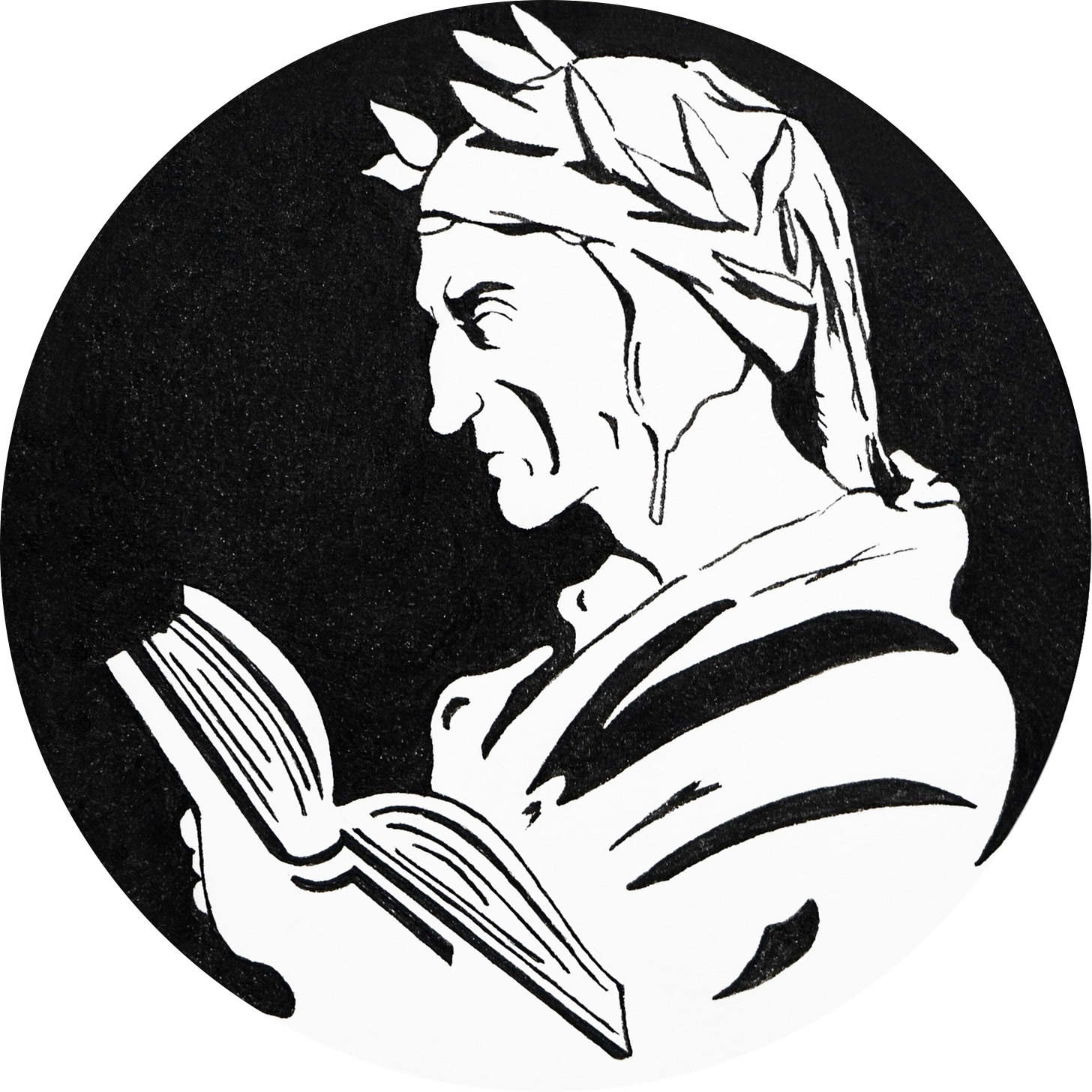

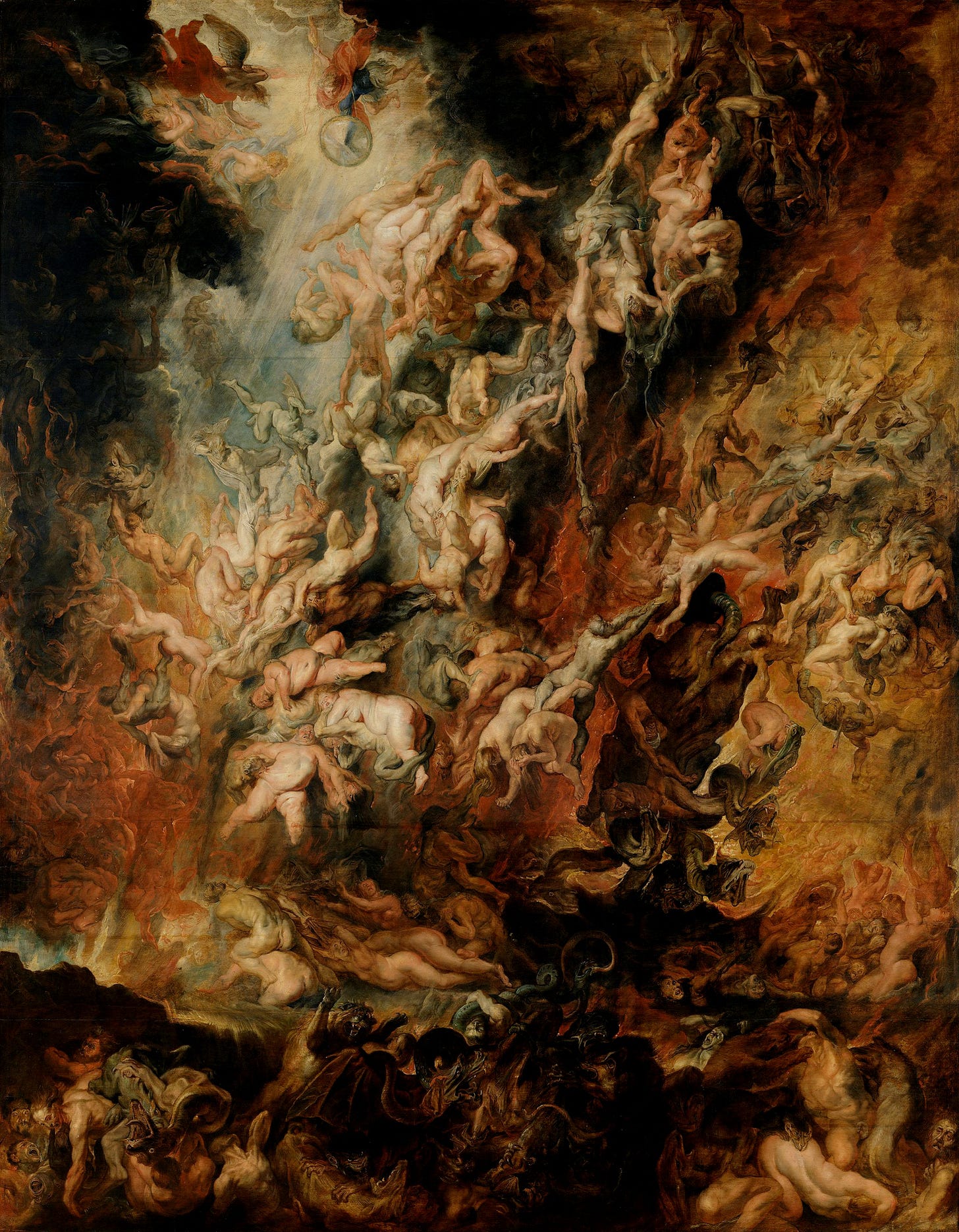

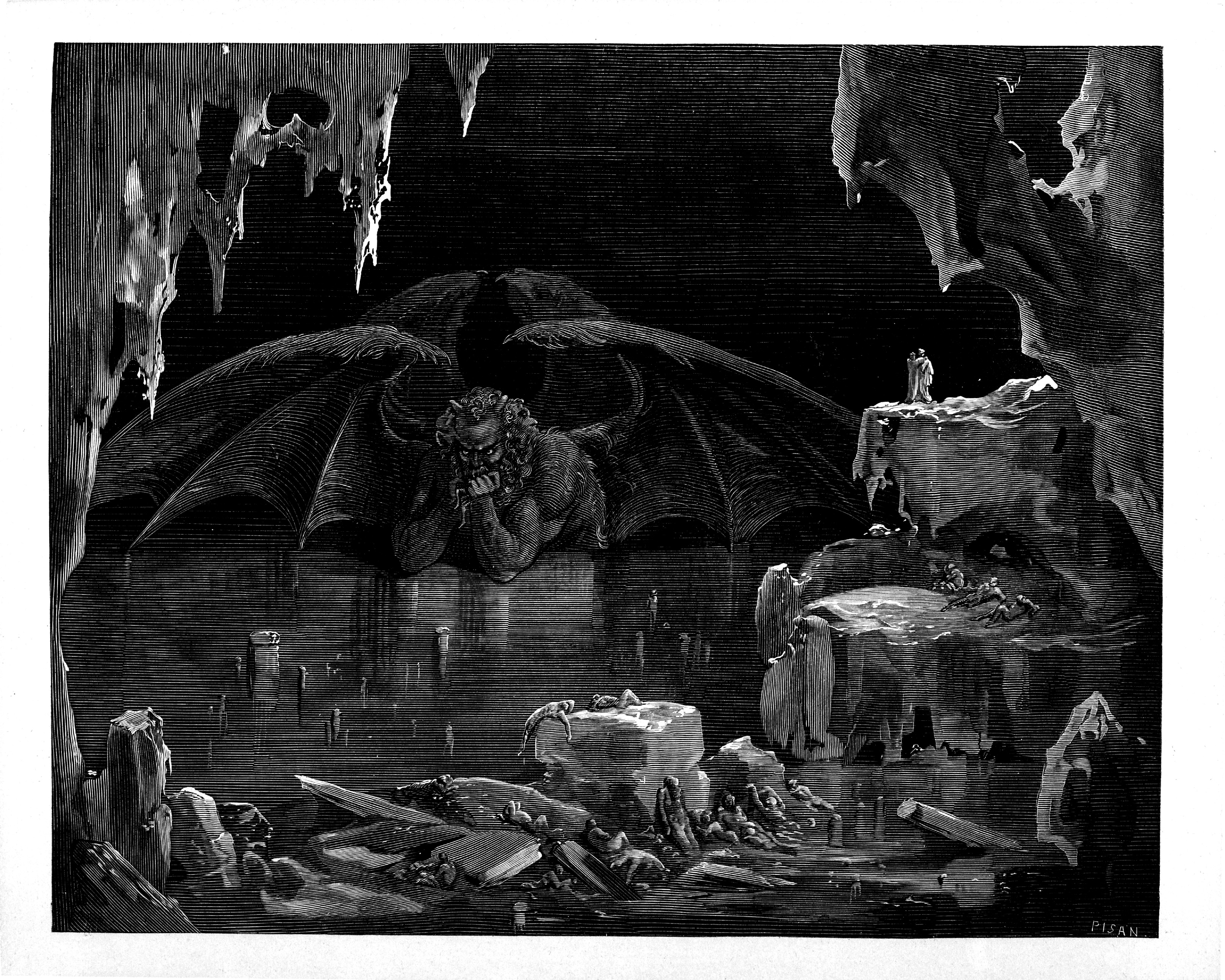

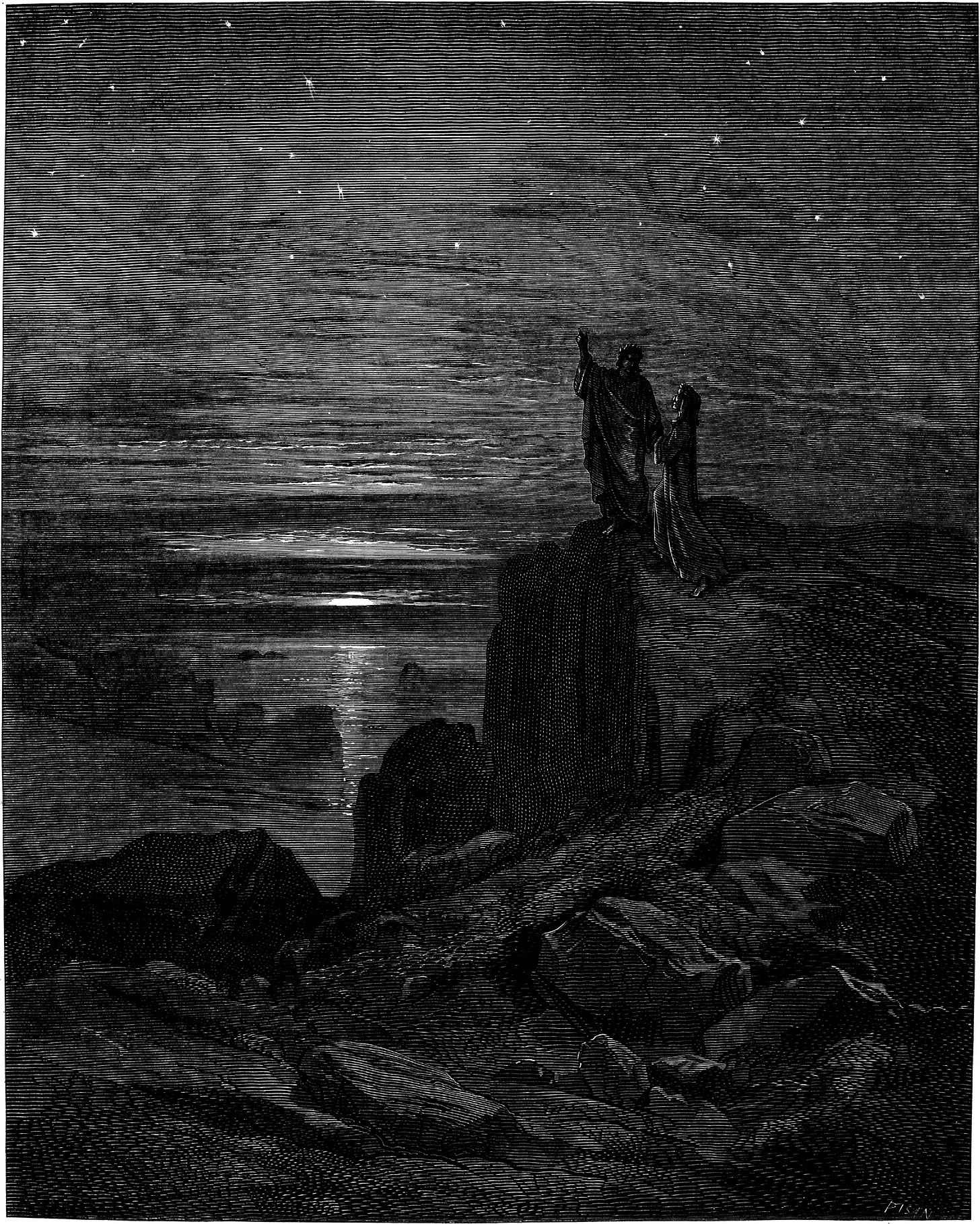

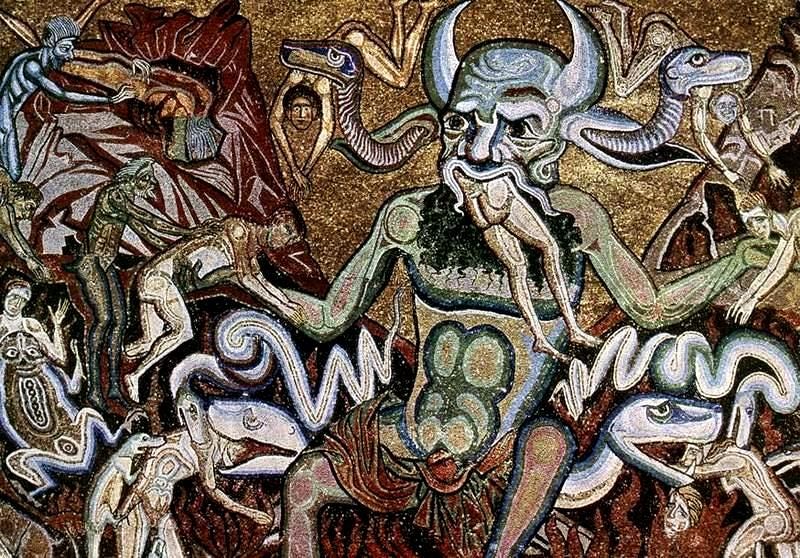

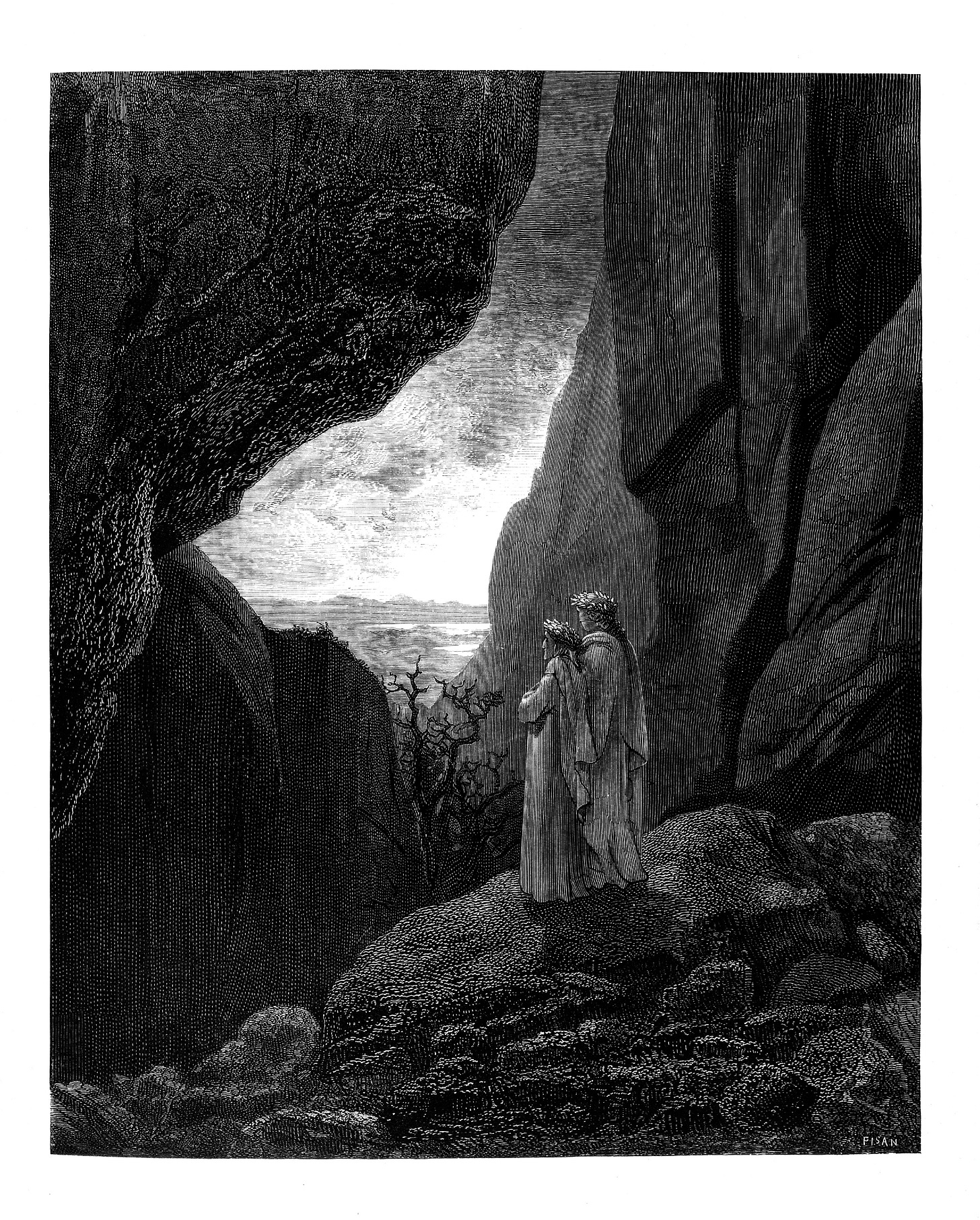

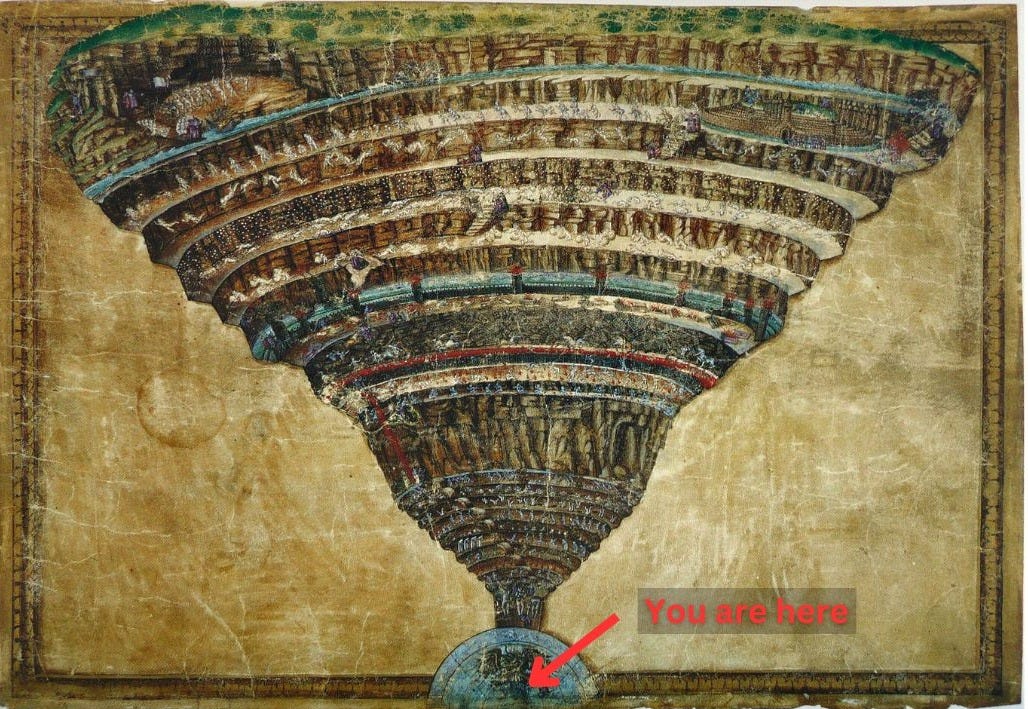

Oh my, we made it! Thank you for all your guidance and amazing posts for each canto. Your insight and dedication brought such deep meaning as we stepped further into hell each week. I look forward to our view of the stars, enjoying the fresh air and moving upward into purgatory together.
I had no idea that I would actually read through Inferno this year. Your read along has been very inspiring! Thank you for the valuable information, interesting notes, and helpful details. I'm looking forward to read the rest of the book.